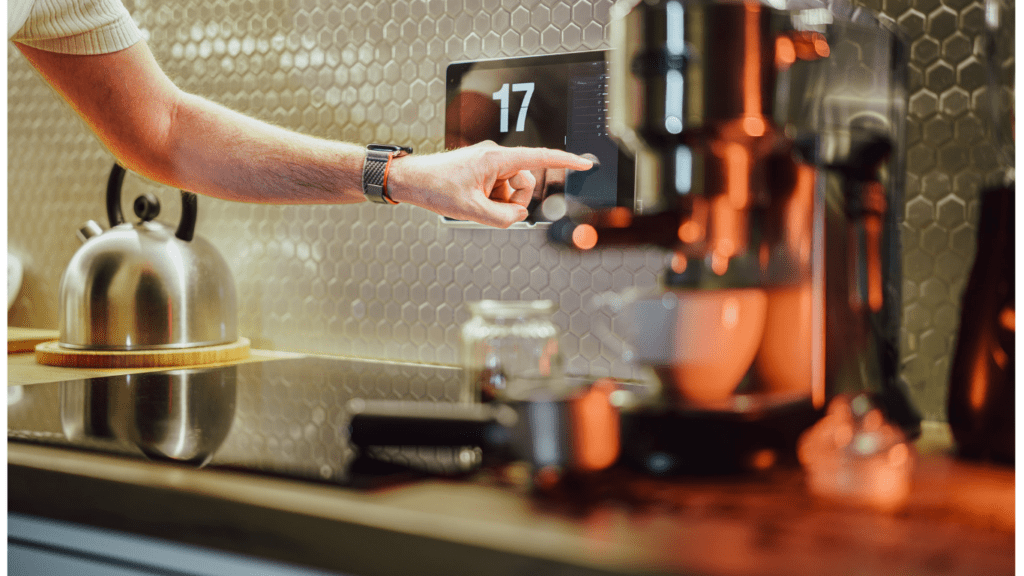Understanding Smart Homes
What Are Smart Homes?
Smart homes use internet-connected devices to manage and monitor various systems and appliances remotely.
These homes feature integrated technologies that automate functions like lighting, heating, and security.
Smart homes improve efficiency and provide convenience, and contribute to a more energy-conscious lifestyle.
According to Statista, 53.9 million homes in the United States will be classified as smart by 2023.
The Role of IoT Devices in Smart Homes
- IoT devices play a crucial role in smart homes by connecting various systems and appliances to the internet.
- These devices communicate with each other, enabling automated and remote control functions.
Examples include smart thermostats, which optimize home temperatures, and smart locks, which enhance security. - IoT devices improve convenience by allowing users to control their home settings via smartphones.
- Data collected from these devices help users make informed decisions about energy use, ultimately contributing to a more sustainable living environment.
Benefits of Smart Homes
Energy Efficiency and Cost Savings
Smart homes offer considerable energy efficiency by utilizing IoT devices like smart thermostats and smart lighting systems.
These devices allow precise control over energy usage which reduces waste.
For example, smart thermostats can learn a user’s schedule and adjust temperatures accordingly, saving up to 10% on heating bills.
Smart lighting systems switch off lights in unoccupied rooms, further lowering energy consumption.
According to the U.S. Department of Energy, energy-efficient devices can decrease household energy use by up to 30%.
Enhanced Security and Safety

Enhanced security is another significant benefit of smart homes.
IoT devices like:
- smart locks
- video doorbells
- security cameras
provide advanced security features. For instance, smart locks enable remote access control, allowing users to lock or unlock doors from anywhere.
Video doorbells show live footage of visitors, deterring potential intruders.
A study by SafeHome.org reveals that homes with security cameras are 300% less likely to be broken into.
Moreover, smart smoke detectors and leak sensors offer real-time alerts, ensuring immediate action in emergencies.
Convenience and Remote Monitoring
Convenience and remote monitoring are crucial aspects of smart homes. IoT devices streamline daily tasks and facilitate remote control of home systems.
Smart assistants like Amazon Alexa and Google Home can control devices via voice commands, making it easier to manage home environments.
Users can monitor and operate appliances from smartphones, ensuring peace of mind when away from home.
For example, a smart refrigerator can send notifications if the door is left open.
According to a TechRadar report, 62% of smart home users say their systems save time, adding to the overall user experience.
Essential IoT Devices for Your Smart Home
1. Smart Thermostats
Smart thermostats allow precise temperature control for homes, optimizing energy usage. Users can program schedules based on their routines, cutting down energy waste.
Popular models like the Nest Thermostat auto-adjust temperatures and learn user preferences.
Research by the Environmental Protection Agency shows that smart thermostats can lower energy bills by 8-15%.
Integration with voice assistants facilitates hands-free adjustments, enhancing convenience.
2. Smart Security Systems
Smart security systems offer advanced protection and monitoring for homes. These systems include smart cameras, locks, and alarms.
Devices like the Ring Video Doorbell provide real-time video feeds and motion detection alerts.
According to a SafeWise report, homes with security systems are 60% less likely to be targeted by intruders.
Remote access through smartphones enables users to monitor their property, lock doors, and receive alerts from anywhere, ensuring peace of mind.
3. Smart Lighting and Appliances
Smart lighting and appliances boost both convenience and energy efficiency. Smart bulbs, like Philips Hue, allow users to control lighting intensity and color through apps or voice commands.
They support preset schedules and automation, reducing power consumption. Smart appliances, such as Samsung’s Family Hub
Refrigerator, offer features like inventory management and energy-efficient operation.
Integration with ecosystems like Amazon Alexa or Google Assistant centralizes control, streamlining daily tasks and improving the overall living experience.
Challenges in Integrating IoT Devices
Compatibility Issues
Device compatibility creates significant challenges in integrating IoT devices in smart homes.
Different manufacturers often use proprietary standards, making it difficult for devices to communicate.
For instance, a smart thermostat from one brand may not sync with a smart lighting system from another.
To mitigate this, consumers can look for devices supporting common standards like Zigbee or Z-Wave.
Security and Privacy Concerns
Security risks and privacy issues arise when integrating IoT devices. Internet-connected devices can be vulnerable to cyber-attacks, potentially exposing personal data.
For example, hackers can access smart cameras, compromising user privacy.
Homeowners should adopt strong security measures like using robust passwords, enabling two-factor authentication, and ensuring devices receive regular firmware updates to counter these threats.
Future Trends in Smart Home Technology
Advances in AI and Machine Learning
Advances in AI and machine learning are transforming smart homes. AI algorithms can now learn user preferences, optimizing home automation systems.
For example, smart thermostats adjust temperatures based on past usage and real-time data, improving energy efficiency.
Machine learning also enhances security by identifying unusual patterns, alerting homeowners to potential threats.
Devices like smart cameras and doorbells use AI for facial recognition, providing personalized and automated responses.
The integration of AI in voice assistants, like Amazon Alexa and Google Assistant, makes daily interactions smoother and more intuitive, managing multiple tasks through simple voice commands.
Integration with Renewable Energy Sources
The push for renewable energy integration is reshaping smart home technology.
Homes equipped with solar panels, wind turbines, or energy storage systems benefit from smart grid interactions, balancing energy consumption and generation.
Smart energy management systems monitor energy usage and optimize consumption based on peak hours and renewable energy availability.
For instance, EV chargers schedule charging sessions during periods of low energy demand or abundant solar power.
This integration reduces dependence on non-renewable sources, cutting utility costs and fostering environmental sustainability.
Smart homes adopting these innovations can achieve an eco-friendly lifestyle while maximizing efficiency.

